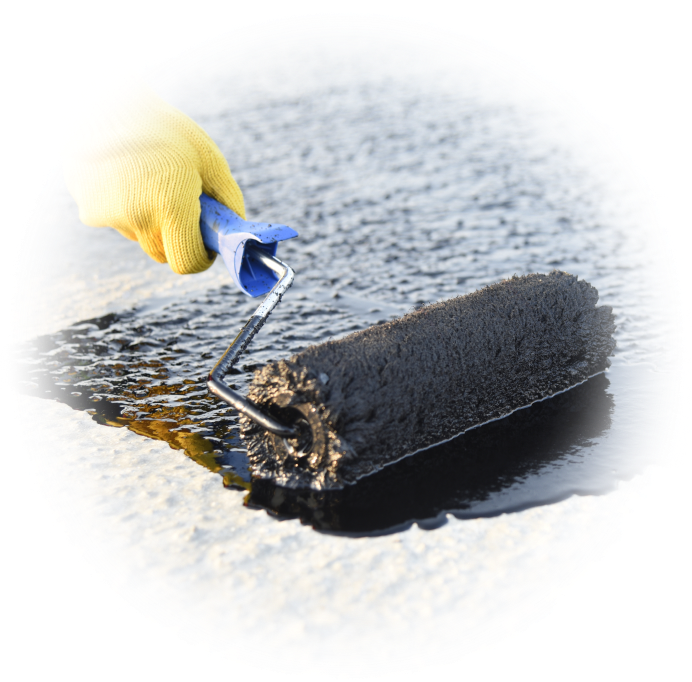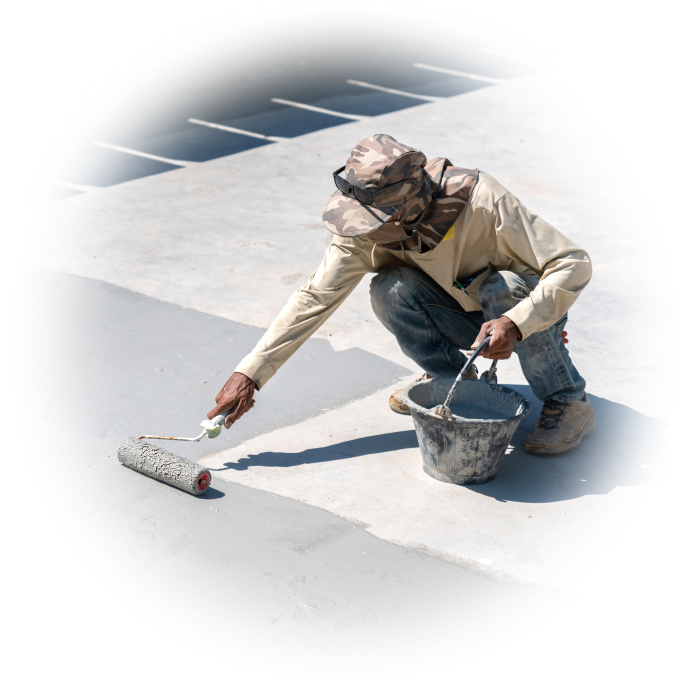Concrete Waterproofing
Home | Injection Systems | Concrete Waterproofing
Concrete is durable—but not impervious to water. Without adequate protection, water ingress can compromise its structural integrity, leading to cracks, corrosion, and long-term damage. Our concrete waterproofing solutions are designed to safeguard critical infrastructure, offering long-lasting protection for commercial, industrial, and government facilities across Singapore. Whether applied during construction or as a remedial treatment, our systems provide reliable defence against moisture intrusion.
Why Is Concrete
Waterproofing Necessary?
Concrete may appear solid, but its porous nature allows water to seep in over time. Without a robust concrete waterproofing system, moisture can travel through capillaries within the structure, causing rusting of reinforcement bars, weakening of the concrete matrix, and eventual structural failure. In environments exposed to high humidity, rainfall, or hydrostatic pressure—such as basements, tunnels, and retaining walls—waterproofing becomes a critical part of long-term structural performance and safety.

Benefits of Concrete Waterproofing
Early detection of water ingress is essential to prevent extensive damage and initiate timely leakage repair works. Look for these tell-tale signs:
Prevents Water Ingress
A high-performance waterproofing system blocks water pathways, protecting structures from leaks, seepage, and flooding-related issues.
Enhances Structural Durability
Preventing moisture from reaching internal reinforcements helps maintain load-bearing capacity and extends the structure’s service life.
Minimises Maintenance Costs
Effective concrete waterproofing reduces the need for frequent repairs, protecting against corrosion, surface damage, and internal deterioration.
Improves Indoor Conditions
By reducing dampness, waterproofed concrete contributes to healthier environments—free from mould, mildew, and air quality issues.
Supports Compliance and Asset Value
Proper waterproofing helps meet building code requirements and ensures that commercial and government facilities maintain their asset value over time.
Our Concrete
Waterproofing Methods
Surface Coating
Liquid-applied membranes form a waterproof film over concrete surfaces, offering flexible protection against water ingress and surface wear. Commonly used in concrete waterproofing applications across basements, roofs, and retaining walls, these coatings penetrate and bond tightly to the substrate. This ensures long-term resistance to water ingress, chemical exposure, and thermal movement, essential for Singapore’s humid, tropical environment.
Crystalline Waterproofing
Applied as a slurry or dry-shake, these products penetrate concrete and form insoluble crystals within capillaries, blocking water movement internally. These crystals seal capillaries and microcracks, providing self-healing protection against water penetration from both positive and negative sides. This internal concrete waterproofing method ensures lasting durability and low maintenance even under high hydrostatic pressure
Cementitious Waterproofing
Comprising cement-based compounds blended with specialised waterproofing additives, this coating forms a durable bond with concrete surfaces to prevent water seepage and structural deterioration. Ideal for basements, water tanks, and wet areas, it provides a breathable yet watertight layer that withstands hydrostatic pressure, ensuring reliable, long-term concrete waterproofing performance even in demanding conditions.
PU Injection and Grouting
Polyurethane (PU) injection grouting is a highly effective method for stopping active water leaks in existing concrete structures. The expanding resin penetrates deep into cracks and joints, reacting with moisture to form a flexible, watertight seal. This targeted concrete waterproofing solution provides rapid results, minimal disruption, and long-lasting protection for basements, tunnels, and retaining walls.
Waterproofing Membranes
Sheet membranes provide a robust and continuous barrier against moisture infiltration, effectively protecting concrete foundations and below-slab systems. Installed either below or above grade, these membranes resist punctures, chemical attack, and ground movement. Their high tensile strength and watertight seams make them a reliable choice for long-term concrete waterproofing in both residential and commercial structures.
Process of Concrete Waterproofing
ADCOS Asia offers industry-grade systems to treat and prevent water ingress across complex structures. Our leakage repair methods are engineered for large-scale and government projects, ensuring long-term protection in critical environments:
Site Inspection and Diagnosis
We assess the site’s exposure, existing damage, and structural layout to recommend the most suitable waterproofing approach.
Surface Preparation
All surfaces are cleaned, repaired, and prepared to ensure strong adhesion and optimal performance of the chosen waterproofing system.
Material Selection and Application
Based on site conditions, we apply the appropriate solution—be it coating, crystalline, membrane, or injection—to ensure complete coverage and sealing.
Curing and Quality Checks
The waterproofing system is cured and tested for consistency, adhesion, and effectiveness. A final inspection is carried out to validate coverage.
Limitations and Challenges of Concrete Waterproofing
While concrete waterproofing systems offer essential protection for structures, their long-term performance depends on correct design, application, and site conditions. Understanding the following challenges helps ensure more effective and durable waterproofing results.
1. Surface Preparation and Application Quality
Proper surface preparation is critical to achieving strong adhesion and watertight performance. Contaminants, dust, or uneven surfaces can prevent coatings or membranes from bonding fully, leading to premature failures. Skilled workmanship and strict adherence to manufacturer guidelines are vital to prevent these issues.
2. Cracks and Structural Movement
Concrete naturally expands, contracts, and settles over time. Without flexible materials or joint detailing, these movements can cause cracks that compromise waterproofing integrity. Systems must accommodate thermal and structural shifts to maintain a continuous barrier against water ingress.
3. Environmental and Site Conditions
High humidity, unpredictable rainfall, and temperature variations, especially in tropical climates like Singapore, can delay curing or reduce coating performance. Scheduling application under optimal conditions and using products suited to local environments improve long-term results.
4. Compatibility Between Systems
Combining multiple waterproofing systems (e.g. sheet membranes with injection grouting) may lead to compatibility issues if materials react or fail to bond properly. Selecting compatible products and ensuring correct sequencing during installation is essential for a cohesive waterproofing design.
5. Maintenance and Inspection
Even well-installed concrete waterproofing systems require periodic inspection to detect damage, wear, or chemical exposure. Neglecting maintenance can allow small breaches to escalate into costly repairs. Proactive monitoring helps extend the system’s service life and maintain structural protection.

Maintenance Tips for Concrete
Waterproofing
Maintaining your concrete waterproofing system is essential for long-term effectiveness. Regular inspections should be scheduled to check for surface wear, joint movement, or new cracks. Keep drainage systems unblocked to reduce hydrostatic pressure against waterproofed surfaces.
When cleaning treated areas, avoid abrasive tools or harsh chemicals that may degrade protective coatings. Should minor damage occur, prompt patch repair or injection sealing will prevent more significant issues from developing.
Frequently Asked Questions
What are the main challenges in achieving effective concrete waterproofing?
Common challenges in concrete waterproofing include poor surface preparation, incorrect product selection, and inconsistent application methods. Cracks, structural movement, or extreme humidity can also reduce system performance over time. Engaging experienced applicators and using quality materials ensure a durable, watertight finish suitable for Singapore’s climate.
What factors affect the cost of concrete waterproofing?
The cost of concrete waterproofing depends on several factors, including the structure’s size, accessibility, and the waterproofing system selected. Methods such as PU injection, sheet membranes, or crystalline coatings vary in price due to their materials and application requirements. Although the initial investment may differ, effective waterproofing helps prevent costly structural damage and future repairs.
How long does concrete waterproofing last?
With proper installation and maintenance, waterproofing systems can last 10–25 years or more. Performance depends on environmental exposure, materials used, and ongoing care.
Is concrete waterproofing necessary for above-ground structures?
Yes. Even above-ground elements are exposed to rain, humidity, and thermal stress. Waterproofing protects facades, balconies, and rooftop slabs from surface damage and internal degradation.
Can existing structures be retrofitted with concrete waterproofing?
Absolutely. Remedial waterproofing, including PU grouting and coatings, can be applied to existing concrete to restore protection and seal leaks without structural overhaul.


 ADCOS Asia
ADCOS Asia